Enterprise leaders know that incident response is no longer a reactive function, but a business-critical capability. According to a study, unplanned downtime costs organizations an average of $250,000 per hour. In sectors such as construction or healthcare, the fallout encompasses more than just lost revenue. They also have to consider compliance exposure and reputational risk.
Yet, many teams still rely on emails, spreadsheets, and outdated tools, which slow response times and weaken accountability. The right incident management software does more than fix issues. It prevents escalation, enforces service-level agreements (SLAs), and provides teams with real-time visibility.
In this article, we’ve compiled the best incident management software for enterprises in 2025, built for speed, scale, and seamless integration.
Top 5 Incident Management Software Tools for Enterprise in 2025
We’ve reviewed popular incident management tools in the market using insights from sources like G2 and Reddit to help you compare their features clearly.
|
Factor |
FlowForma |
Creatio |
Kissflow |
Appian |
OutSystems |
|
Ease of Use & Automation |
- No-code tool built for non-technical users. Agentic AI and AI Copilot-assisted flow creation and templates to simplify complex incident workflows |
Low-code with drag-and-drop builders Business-friendly, but may need IT for custom logic |
Intuitive no-code builder with guided steps Best for simple incidents |
Advanced automation Better suited to IT-led builds and complex enterprise architecture |
Powerful automation engine with a steeper learning curve for business users |
|
Integration Capabilities |
Native Microsoft 365/SharePoint integration. Connects with CRM, ERP, and external portals for real-time incident input |
Strong CRM and BPM integrations, and connectors for ITSM tools and APIs |
Connects easily with SaaS tools Less robust for IT infrastructure integrations |
Extensive integrations (RPA, AI, legacy systems) Ideal for hybrid IT landscapes |
Broad enterprise connectivity Needs developer support for setup |
|
SLA Management & Reporting |
Built-in SLA timers, routing rules, and dashboards Ensures escalations and SLA tracking without IT intervention |
SLA configuration through the BPM layer Best for structured environments. |
SLA timers available Granular control for precise monitoring. |
SLA monitoring tied to analytics suite Strong, but needs setup support |
Customizable SLA logic Requires dev input and testing |
|
Scalability & Flexibility |
Designed for enterprise complexity Supports multi-department and cross-functional workflows External stakeholders included |
Flexible and modular Scalable across enterprise teams |
Great for internal teams, but external stakeholder workflows may be limited |
Handles massive enterprise workloads with strong governance tools |
Global-scale deployments possible Works best with strong in-house IT |
|
Security & Compliance |
Enterprise-grade security with audit trails, GDPR support, access controls, and Microsoft ecosystem compliance |
ISO-compliant Supports role-based access and industry frameworks |
Meets basic compliance needs |
Advanced compliance certifications (HIPAA, FedRAMP). Best for regulated industries |
Full enterprise compliance stack May require additional configuration for industry-specific needs |
Top 10 Incident Management Software in 2025
Now that we’ve taken an overview of the top five tools, let’s dive into a detailed review of the top 10 incident management tools in detail.
1. FlowForma

Discover how FlowForma enables you to transform ideas into automated processes within seconds.
FlowForma is an AI-powered operations automation tool tailored for IT incident management processes, built for enterprises using Microsoft 365 and SharePoint. Business users can log, route, escalate, and resolve incidents, all without developer support.
Its Agentic AI and AI Copilot features build workflows from prompts, diagrams, or voice. Features like escalation logic, SLA tracking, and real-time dashboards help teams resolve issues quickly and stay compliant.
You can watch the demo to see FlowForma automate an entire incident process in minutes.
FlowForma Pros
- Transparent pricing, no hidden costs
- Agentic AI- and AI Copilot-driven automation
- Works with complex, multi-step workflows
- Easy to use; designed for business users, not developers
FlowForma Cons
- Requires SharePoint and Office 365
- Requires training for advanced features
FlowForma Pricing
 An overview of FlowForma’s pricing page
An overview of FlowForma’s pricing page
FlowForma follows a process-based pricing model and offers three pricing structures, starting at £2,067 per month for up to three processes. Pricing is based on a 12-month contract, billed annually.
FlowForma also offers a 7-day free trial, allowing users to test features before committing.

Mark Lay shares how his team saved over 3,000 hours by working smarter and reducing admin workload.
2. Creatio
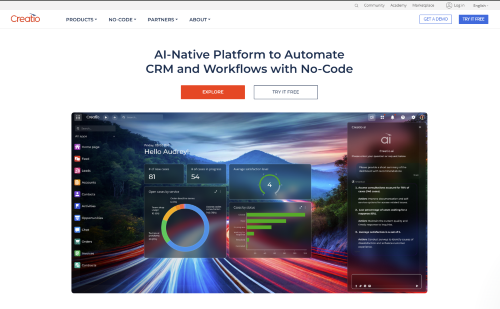
Creatio showcases its AI-native no-code platform for automating CRM and workflows with real-time insights.
Creatio is a low-code platform that blends customer relationship management (CRM) and BPM tools for unified process automation, including incident management. It's built for enterprises that want to manage incidents as part of broader customer or service workflows.
With Studio Creatio, users can configure SLA timelines, automate escalations, and integrate with IT Service Management (ITSM) and CRM systems.
Creatio Pros
- Easy to use even for non-technical users
- Combines CRM and BPM capabilities with native dashboards and customer 360 views
- Offers integration support with APIs and widely used platforms
Creatio Cons
- Outdated and lacking in detail
- Some advanced UI customization options are limited to higher-tier plans
- Documentation and support may fall short for intricate configurations
Creatio Pricing

Creatio plans start at $25/user/month, scaling with automation needs.
Creatio offers a 14-day free trial with full access to its no-code platform and CRM apps without feature limits, and no credit card requirement.
Pricing is modular based on selected features and user count.
3. Kissflow
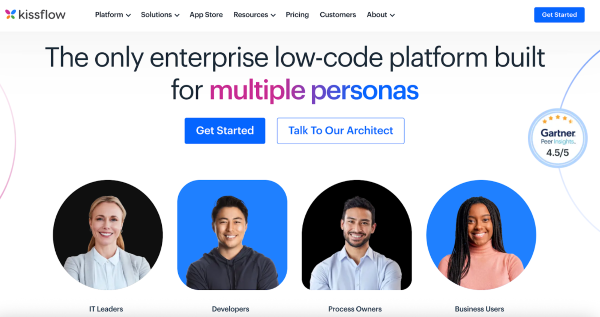
Kissflow is an enterprise low-code platform tailored for diverse roles across the organization.
Kissflow’s incident management capabilities help midsize enterprise teams to streamline service desk requests or internal issue handling without IT involvement. Users can create custom workflows, assign responsibilities, and track issue resolution.
Kissflow Pros
- Intuitive, web-based interface makes it easy to automate workflows, even for non-technical users
- Supports collaboration across teams and multiple locations
- Ease of use and flexibility
Kissflow Cons
- Some users report slowness and trouble accessing the platform
- May lack depth for more complex enterprise needs
- Requires a constant internet connection, which could pose a challenge for environments with slow or limited connectivity
Kissflow Pricing

Kissflow’s Enterprise offers custom pricing for advanced needs
Kissflow offers two pricing models, starting at $1,500 per month for 50 users. Their enterprise plan is best suited for large organizations and offers custom pricing. They also offer a free trial once they confirm that their tool matches your business requirements.
4. Appian

Appian’s dashboard visualizes incidents by type, severity, cost, and location for real-time monitoring.
Appian supports organizations that require in-depth integration with IT systems and advanced automation for high-volume or highly regulated incident workflows. With Appian, teams can design custom incident processes, define SLA timers, and integrate with monitoring tools, but most implementations require IT resources.
Appian Pros
- Low-code/no-code capabilities for quick app and workflow automation
- Works well for automation, API integration, and case management
- Secure and scalable cloud-based platform used across various industries
Appian Cons
- It can get expensive for large or complex implementations
- Lacks advanced AI/ML features compared to some competitors
- Some users find a learning curve and issues with large datasets
Appian Pricing
Appian offers three pricing tiers — Standard, Advanced, and Premium. These pricing variants offer different access to bots, portals, AI features, and data scaling capabilities.
Pricing is customized per user, per app, and based on deployment model.
5. OutSystems

OutSystems enables fast delivery of custom apps and agents using AI and low-code tools.
OutSystems is an AI-powered low-code platform to build custom apps and agents. Their enterprise incident management software is designed for building custom enterprise applications, including incident management tools.
OutSystems Pros
- Enables rapid app development with support for integration and scalability
- Intuitive low-code platform with built-in templates
- An active support community and DevOps tools streamline deployment and troubleshooting
Outsystems Cons
- The licensing model based on specific object types incentivizes poor coding practices to reduce costs
- UI customization can be complex; some platform bugs and a learning curve for advanced use
- PaaS version restricts deep infrastructure control
Outsystems Pricing
OutSystems offers a 10-day free Evaluation Edition. Its pricing models are as follows:
 OutSystems offers a free trial and enterprise plans starting at $36,300 annually.
OutSystems offers a free trial and enterprise plans starting at $36,300 annually.
6. Pega

Pega’s homepage highlights live keynotes and AI insights from its PegaWorld event.
Pega is known for automating complex, high-volume business operations. For incident management in regulated industries, where governance, case management, and audit trails are key.
Pega Pros
- Built for adaptability, integration, UI, AI marketing, and cloud support, it works across channels without changes
- User-friendly interface with drag-and-drop tools supports both developers and business users
- Scalable for large organizations, with features like App Studio and good BPM integration
Pega Cons
- Steep learning curve for advanced features and limited external learning resources
- High memory and RAM usage make it challenging to build applications on low-configuration laptops
- Needs extensive training for each process or module
Pega Pricing
Pega offers custom enterprise pricing tailored to user needs, use cases, and deployment models. Trials and tailored demos are available upon request.
7) Ivanti Neurons for ITSM (Previously Cherwell)
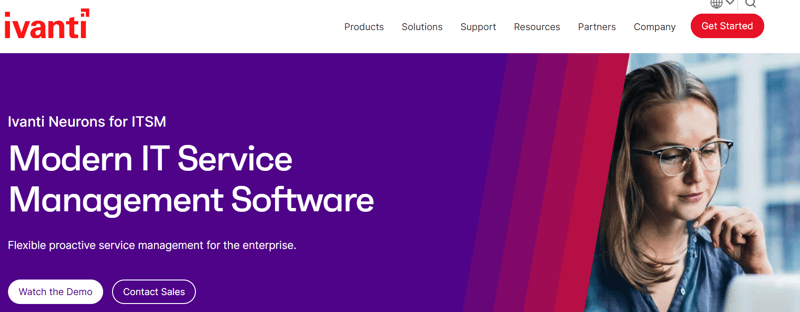
Ivanti highlights tailored ITSM solutions aimed at cost reduction and agile service management.
Ivanti Neurons for ITSM has incident, problem, and change management capabilities. Some of their best-known features include the drag-and-drop workflows that help automate logging, triage, escalation, and SLA tracking.
Ivanti Pros
- Customizable and versatile, adaptable to various workflows across departments
- Remote support and asset management features, including device info access and ticketing integration
- Multiple databases can be synced together
Ivanti Cons
- Complex dashboard customization and limited third-party integration capabilities
- High pricing and inconsistent performance of remote tools or search functionality
Ivanti Pricing
Pricing is quote-based and varies by deployment size and modules selected.

Ivanti offers tiered ITSM plans tailored for teams, departments, and enterprise-wide service needs.
8. ProcessMaker
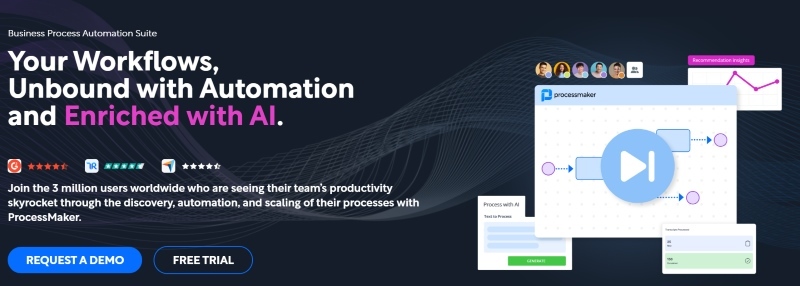
ProcessMaker highlights AI-enhanced automation tools for scaling business processes.
ProcessMaker offers form-based process design, routing, SLA tracking, and integration with enterprise systems. It’s designed for teams that want to build custom, rules-based workflows with a strong visual interface.
ProcessMaker Pros
- Drag-and-drop interface and intuitive workflow setup
- Offers well-documented APIs (JavaScript and PHP) and a user-friendly portal
- Wide range of BPM features, including form building and automation
ProcessMaker Cons
- Per-user licensing model becomes expensive at scale; performance and broken workflows after upgrades are common pain points
- Outdated UI/UX and limited reporting capabilities compared to other platforms; difficult case tracking
- Customer support response time and upgrade stability need improvement
ProcessMaker Pricing
ProcessMaker offers three pricing modules, each with plans that include unlimited processes and secure data management. Higher tiers add decision tables, smart inbox tools, and AI-powered automation.
Pricing is custom and quote-based.
 ProcessMaker offers plans for scaling automation, from basic workflows to AI-powered enterprise solutions.
ProcessMaker offers plans for scaling automation, from basic workflows to AI-powered enterprise solutions.
9. ServiceNow
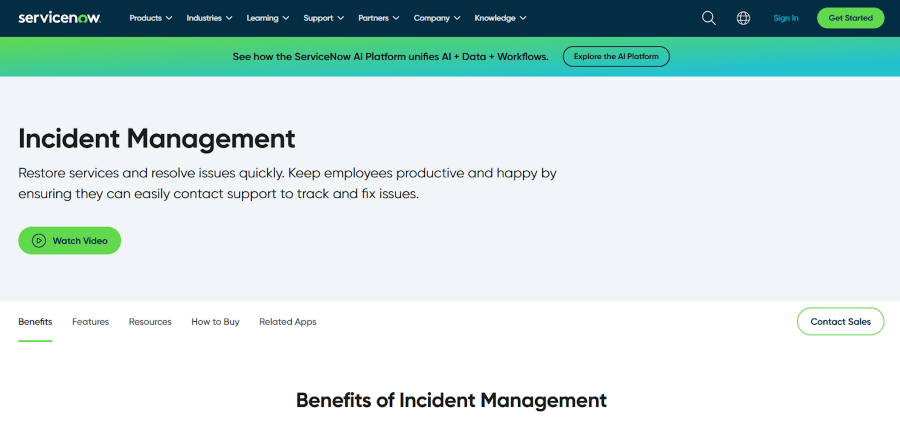
ServiceNow showcases its IT Service Management dashboard for efficient incident tracking and resolution.
ServiceNow is a lightweight ITSM solution for mid-sized businesses, and now offers end-to-end ticketing, SLA enforcement, escalation workflows, and full ITIL alignment.
ServiceNow Pros
- Enables workflow automation, asset management, IT issue tracking, and SLA monitoring.
- User-friendly interface
ServiceNow Cons
- Considered expensive and complex to use
- Navigating item hierarchies can be challenging, and searches occasionally fail even when items exist.
- The backend and GUI are not user-friendly, making configuration challenging to navigate.
ServiceNow Pricing
 ServiceNow offers custom ITSM pricing with scalable packages and tailored assessments.
ServiceNow offers custom ITSM pricing with scalable packages and tailored assessments.
ServiceNow offers scalable packages designed for your business needs. Pricing is customized based on your ITSM requirements, with value assessments available for advanced features like Virtual Agent and DevOps integrations.
10. Zoho Creator
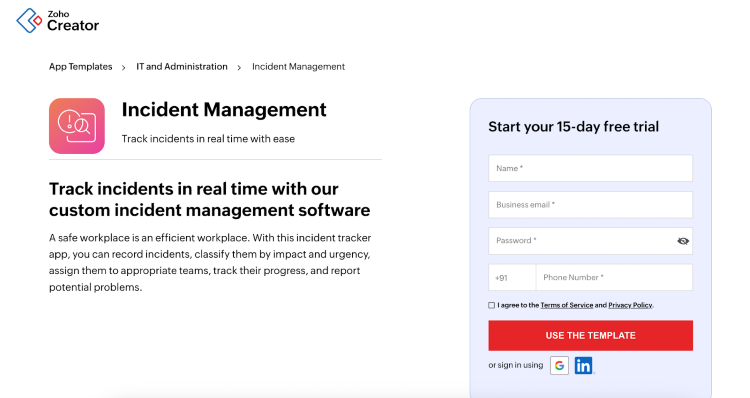
Zoho Creator promotes real-time incident tracking with a customizable management app and 15-day free trial.
Zoho Creator supports simple form-based workflows, notifications, and has integrations with other Zoho tools. It’s customizable, quick to grasp, and integrates seamlessly with other Zoho tools.
Zoho Creator Pros
- Customizable and easy to use, even for non-tech users
- Speeds up app development with drag-and-drop tools and ready templates
- Integrates with other Zoho tools for end-to-end business needs
Zoho Creator Cons
- Limited deep customization and third-party integrations
- The user interface and dashboard design could be better
- Customer support responses can be slow or inconsistent
Zoho Creator Pricing
Zoho Creator offers four pricing modules. Pricing starts at $8 per user per month, billed annually.

Zoho Creator plans range from $8 to $25/user/month, with a Flex option for custom needs.
A 15-day free trial is available, and users can sign up without a credit card.
Key Features to Look for While Selecting Incident Management Software for Enterprises
For enterprises, incident management is no longer a backend function—it’s a frontline business priority. From meeting SLAs to protecting brand reputation, your organization needs a scalable, secure, and customer-centric solution. Choosing the right incident management platform enforces discipline, improving visibility, and ensures teams are aligned with business-critical goals.
Here are the must-have features enterprise leaders should prioritize:
1. Service level agreement management
Efficient SLA enforcement ensures timely resolution and accountability. Choose a tool that allows you to define SLA policies, automate escalations, and generate alerts before breaches occur.
2. Integration with IT and monitoring systems
Enterprise-grade incident management solution tools should be able to integrate with monitoring platforms, ITSM tools, and business systems to trigger incidents automatically and then streamline resolution across departments.
 FlowForma integrates seamlessly to thousands of systems
FlowForma integrates seamlessly to thousands of systems
3. Reporting and analytics
A good tool should provide detailed reports, real-time dashboards, and historical trend analysis, which are key for tracking team performance, identifying bottlenecks, and improving incident response over time.
4. Compliance and security
Be sure that the platform supports access controls, audit logs, and industry compliance (e.g., GDPR, ISO). Secure data handling and role-based permissions are crucial in regulated enterprise environments.
Tools like FlowForma excel here, with a built-in compliance module that automatically generates audit trails, creates tamper-proof digital records, enables multi-level approvals and electronic signatures, and supports document retention and regulatory reporting.
This ensures your incident response process not only meets internal governance but also aligns with external compliance mandates, minimizing risk and protecting your reputation.
 FlowForma's Product Strategist, Paul Stone, describes the benefits of FlowForma Compliance
FlowForma's Product Strategist, Paul Stone, describes the benefits of FlowForma Compliance
AI-Powered Workflow Assistance
Incident management software for enterprises should incorporate AI-powered workflow assistance to streamline and automate the resolution of issues, ensuring faster response times and more efficient resource allocation.
 A diagram showing all the latest AI features of FlowForma
A diagram showing all the latest AI features of FlowForma
AI can help by analyzing incoming incidents, automatically categorizing and prioritizing them based on urgency, and suggesting appropriate actions or solutions. This reduces manual intervention, minimizes human error, and enables IT teams to focus on critical issues.
Additionally, AI-driven workflows can predict potential problems based on historical data, proactively managing incidents before they escalate. This level of automation enhances the overall efficiency of incident response, improves resolution times, and ensures that enterprises can maintain business continuity with minimal disruption.
Why FlowForma Stands Out as the Best Incident Management Software for Enterprises
FlowForma is a powerful no-code platform designed to streamline and automate incident management for enterprises. Its comprehensive features empower business users to handle incidents efficiently without heavy IT involvement.
Its key features include:
Incident Reporting
FlowForma allows users to quickly build customized forms and workflows for incident reporting, ensuring that all critical information is captured accurately from the start.
Routing and Tracking
Incidents are automatically routed to the right teams or personnel, with full tracking throughout the lifecycle. This visibility helps ensure timely handling and reduces bottlenecks.
Automated Incident Management Workflows
The platform automates complex workflows, such as covering assessment, escalation, and resolution, by using AI-assisted tools that simplify process creation and scaling without IT dependency.
Document Generation
Generate audit-ready PDF reports instantly, providing formal documentation of incidents and outcomes to support compliance and review.
Visibility and Reporting
Real-time dashboards and detailed analytics enable process owners to monitor incident queues, track SLA performance, and identify trends for continuous improvement.
FlowForma’s Agentic AI and Copilot capabilities revolutionize incident management automation by enabling organizations to swiftly design and implement tailored workflows without the need for coding expertise.
Leveraging natural language instructions, users can instruct Copilot to construct comprehensive incident management processes, encompassing steps such as incident identification, categorization, prioritization, resolution, and recovery.
Additional Enterprise Benefits
- Seamless Microsoft 365 and SharePoint integration ensures secure, compliant data handling at scale.
- Offline mobile access enables frontline teams to log incidents anytime, anywhere.
- Trusted by industries including construction, healthcare, and manufacturing for robust incident management solutions.
In this recorded webinar, Abingdon and Witney College share how they saved over 320 hours by transforming their incident reporting into a fully automated, streamlined workflow. Watch the video to learn more.
Want to discover how AI-powered process automation can streamline your incident management? Book a live demo with FlowForma today.
.png) By
By 




